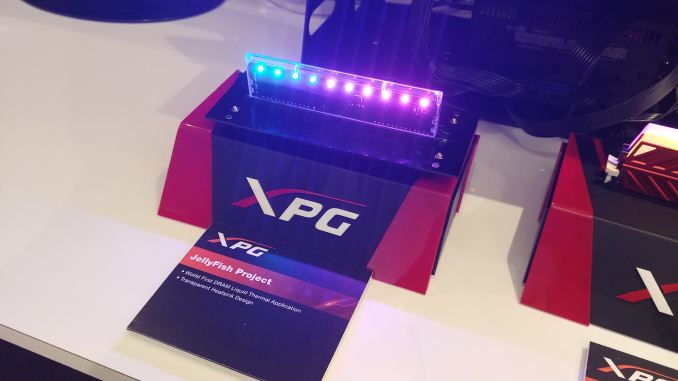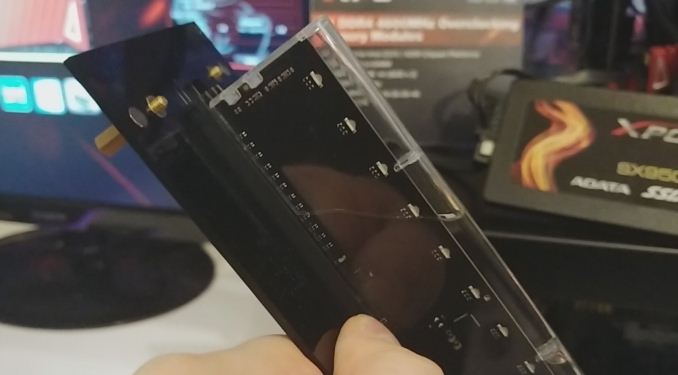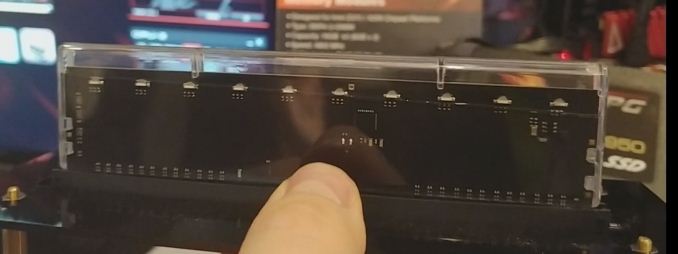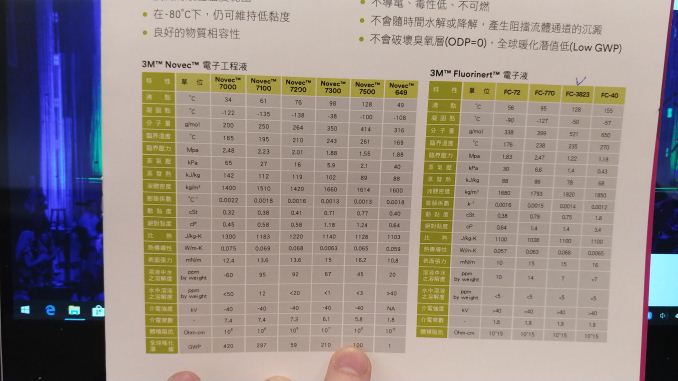ADATA at CES 2018: Jellyfish DRAM
by Ian Cutress on January 16, 2018 8:00 AM EST- Posted in
- Memory
- ADATA
- DDR4
- Trade Shows
- Liquid Cooling
- DRAM
- 3M
- CES 2018
- Jellyfish
- Novec
- Fluorinert

LAS VEGAS, NV – Over the years, DRAM heatsinks have gone from non-existent, to gaudy, to death traps with jagged edges, to some form of LED hell. In the middle we saw some DRAM vendors produce modules for water cooling with pre-applied water cooling pipes and heatsinks, but these were not overly popular. ADATA thinks they have the next step in DRAM cooling technology.
The concept of these ‘Jellyfish’ modules is that by using a sealed and clear plastic case around the memory chips, the case can be filled with a non-conductive liquid, such as 3M Novec/Fluorinert that we have seen in custom PCs and server cooling. These chemicals, basically long chain hydrocarbons with funny bits on the end, are liquid at room temperature but can eventually change state into a gas and rise. That state change can absorb a lot of energy being produced, and as long as the energy is removed and the chemicals become liquid again by cooling down, the liquid forms a convection current and in essence, a heat pump. Even if the chemical does not change state from liquid to gas, with the right viscocity, warm liquid will also cause a convection current.
So cue ADATA’s Jellyfish: bare DRAM modules, in a plastic case, with about a spoonful of 3M Fluorinert. The modules also have a dozen LEDs for good measure.
Normally this 3M liquid is not cheap: over 10 years ago, when enthusiasts realized that mineral oil PCs were more hassle than they were worth, a number of people experimented at a cost of $300 per gallon (they didn’t state US or UK gallon). According to ADATA, the 3M liquid is now about $100 per litre. If you want to do the conversion, it means it is more expensive today than it used to be. A spoonful of this stuff, per module, will still add some cost to a build. But as a prototype, it is certainly an interesting change from all the LED DRAM we see out there.
One caveat, which ADATA noted, is that the prototype was not completely filled. This would mean that when placed vertically in a case, a couple of DRAM chips would not be covered. Jellyfish is still in its early stages of development, so if it ever comes to retail, there might be some changes. ADATA stated that due to the design, they have a patent on this technology, so it will be interesting to see if anything can come from that.
Related Reading
- ADATA Unveils New XPG RGB DDR4 Kits
- ADATA Announces XPG Storm: A Cooler for M.2 SSDs with a 16500 RPM Fan
- ADATA Premier and XPG SDXC and microSDXC Cards Review
















18 Comments
View All Comments
nevertell - Tuesday, January 16, 2018 - link
Does this mean that the RAM will be sensitive to the orientation of the motherboard? I.e. it will cool better (thus be more capable) when the motherboard is laid down horizontally? I can't imagine this working all that well when installed in a regular up-right ATX case. It would still cool something, but it wouldn't be nearly as efficient as just some metal.PeachNCream - Tuesday, January 16, 2018 - link
It looks like a pathway to driving up profit per unit sold by offering a largely unneeded benefit in order to differentiate one commodity DRAM module from another. The industry in general has been doing a good job of that lately, making up for falling sales numbers in overall computer components by adding bling in order to create a premium gaming/fashion/luxury tier as the market pivots to mobile, endangering desktop computing profits. The trouble is that raising the price of entry only further discourages sales and makes desktop gaming systems an even narrower niche.Freakie - Tuesday, January 16, 2018 - link
That's correct! The reason why the module in the video isn't completely full, is because it needs space for the liquid to turn into its gaseous state and then condense once cooled. If it was filled enough to cover all the IC's when mounted vertically, it would probably severely hamper its cooling performance.MajGenRelativity - Tuesday, January 16, 2018 - link
It's at least an interesting idea. Companies innovating and trying new ways like this can move the market forward, so I hope something can come of it, or at least that ADATA keeps trying new things.nerd1 - Tuesday, January 16, 2018 - link
It's a stupid idea... without a proper radiator or heatsink, the heat will just increase the temperature of the oil and that's it.essemzed - Tuesday, January 16, 2018 - link
This! And what PeachNCream said above.Also remember: "Fluorinert absorbs UV wavelengths readily and has a long atmospheric lifetime. As such it has a very high global warming potential ("GWP") of 9,000.[6] As such, it should be carefully managed and used in closed systems only so as to minimize emissions." (from: https://en.wikipedia.org/wiki/Fluorinert)
masouth - Wednesday, January 17, 2018 - link
only 9000? I was really hoping for over 9000!!!edzieba - Tuesday, January 16, 2018 - link
Ramsinks: for when you want to burn money on bits of metal that serve absolutely no function whatsoever, but do cause compatibility issues.r3loaded - Tuesday, January 16, 2018 - link
I don't want heatsinks, LEDs or Fluorinert, I just want DRAM at not-stupid prices. The relevant antitrust body ought to be out there cracking skulls right now.AndrewJacksonZA - Tuesday, January 16, 2018 - link
This! This! So much this!I paid +-USD75 for my 16GB 2133MHz HyperX Fury stick of RAM in November 2016. In November 2017 it was USD150. I just checked today and it is now USD165.
What the?!?!